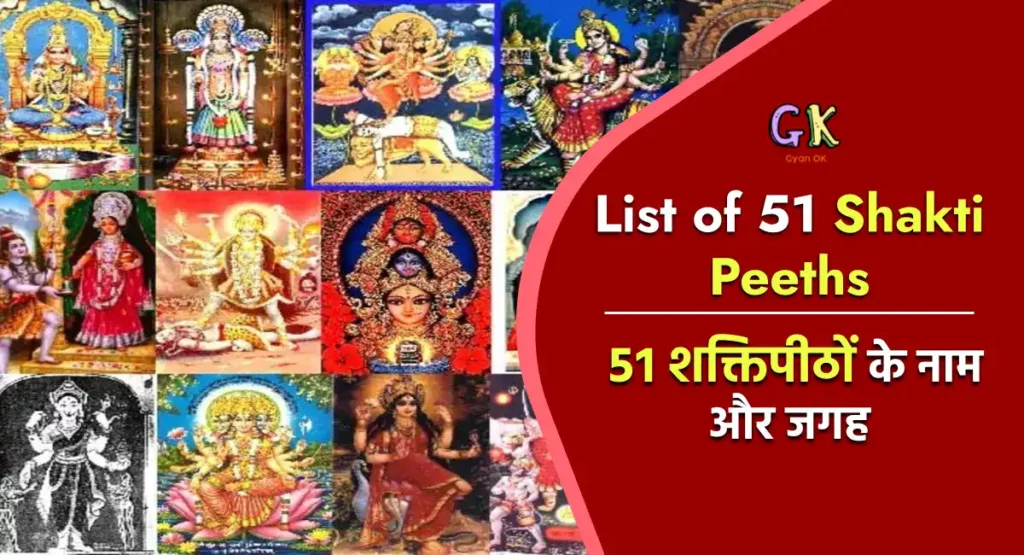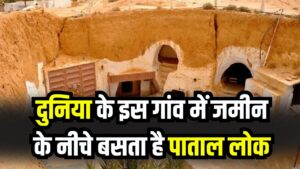The article provides a comprehensive list of various Shakti Peeths, sacred Hindu shrines dedicated to the goddess Shakti. These Peeths are scattered across India and neighboring countries, each associated with a unique legend and divine significance. The article delves into their locations, showcasing the rich diversity of these spiritual sites, which continue to attract pilgrims and devotees from all over the world.

What is Shakti Peeth?
Shakti Peeths are revered sacred sites in Hinduism that are dedicated to the goddess Shakti, the divine feminine energy and consort of Lord Shiva. These Peeths are believed to be the spots where various body parts or ornaments of the goddess Sati fell when her body was dismembered by Lord Vishnu’s Sudarshana Chakra in a fit of rage. Each Shakti Peeth is associated with a specific body part or symbol of the goddess and carries unique religious and mythological significance.
Following are 51 Shakti Peeths along with their body part and places.
| S.No | Temple Name | Location | Associated Body Part or Symbol |
|---|---|---|---|
| 1 | Kamakhya Temple | Assam, India | Womb |
| 2 | Vaishno Devi Temple | Jammu and Kashmir, India | Right Arm |
| 3 | Jwalamukhi Temple | Himachal Pradesh, India | Tongue |
| 4 | Tara Tarini Temple | Odisha, India | Stana (Breast) |
| 5 | Kalighat Kali Temple | Kolkata, India | Toes and Right Ankle |
| 6 | Sati Pith Temple | West Bengal, India | Various Body Parts |
| 7 | Naina Devi Temple | Himachal Pradesh, India | Eyes |
| 8 | Bhairavi Temple | Tamil Nadu, India | Navel |
| 9 | Hinglaj Mata Temple | Balochistan, Pakistan | Head |
| 10 | Chamunda Devi Temple | Himachal Pradesh, India | Upper Palate (Mouth) |
| 11 | Mahakal Temple | Ujjain, India | Upper Lip |
| 12 | Yogmaya Temple | Delhi, India | Bala (Infant Form) |
| 13 | Vindhyavasini Temple | Vindhyachal, India | Left Breast |
| 14 | Alampur Jogulamba Temple | Telangana, India | Upper Teeth and Gum |
| 15 | Brhamaravinasini Temple | Varanasi, India | Part of the Neck |
| 16 | Prayag Madhaveswari Temple | Prayagraj, India | Fingers |
| 17 | Jayanti Devi Temple | Pithoragarh, India | Lower Lip |
| 18 | Mithila Sati Temple | Nepal | Left Shoulder |
| 19 | Panchsagar Temple | Bangladesh | Lower Teeth |
| 20 | Kalmadhav Temple | Amarkantak, India | Left Buttock |
| 21 | Ambaji Temple | Gujarat, India | Heart |
| 22 | Kamakshi Temple | Kanchipuram, India | Navel |
| 23 | Sugandha Temple | Bengal, India | Nose |
| 24 | Bhavanarayani Temple | Chhattisgarh, India | Right Leg |
| 25 | Devi Patan Temple | Nepal | Right Thigh |
| 26 | Srisailam Temple | Andhra Pradesh, India | Neck |
| 27 | Prabhas Shakti Peeth | Gujarat, India | Stomach |
| 28 | Shri Parvat Temple | Himachal Pradesh, India | Ankle |
| 29 | Attahas Temple | Bardhaman, India | Lower Lip |
| 30 | Bhramari Devi Temple | Assam, India | Left Hand |
| 31 | Manas Temple | Tibet | Right Hand |
| 32 | Bimala Temple | Puri, India | Feet |
| 33 | Kumari Temple | Kanyakumari, India | Back |
| 34 | Ramagiri Shakti Peeth | Adilabad, India | Left Thigh |
| 35 | Surkanda Temple | Uttarakhand, India | Head |
| 36 | Kapalini Temple | West Bengal, India | Skull |
| 37 | Jaya Durga Temple | Kangra, India | Left Toe |
| 38 | Chandranath Temple | Chattogram, Bangladesh | Right Shoulder |
| 39 | Katyayani Temple | Chattogram, Bangladesh | Sword |
| 40 | Mahalaxmi Temple | Maharashtra, India | Right Hand |
| 41 | Nalhati Tara Temple | Birbhum, India | Left Eye |
| 42 | Kankalitala Temple | Birbhum, India | Bone |
| 43 | Siddhida Temple | West Bengal, India | Shoulder and Left Trunk |
| 44 | Mukkalingam Temple | Tamil Nadu, India | Neck Vertebra |
| 45 | Kireet Temple | West Bengal, India | Crown |
| 46 | Sankari Temple | West Bengal, India | Navel |
| 47 | Keshari Temple | West Bengal, India | Hair |
| 48 | Malini Temple | West Bengal, India | Necklace |
| 49 | Tara Devi Temple | Himachal Pradesh, India | Eye |
| 50 | Karveer Nivasini Temple | Kolhapur, Maharashtra, India | Left Toe |
| 51 | Chamundeshwari Temple | Mysore, Karnataka, India | Hair |
Mythology of Shakti Peeth
Sati, also known as Dakshayani, was a devoted and virtuous wife of Lord Shiva. However, her father, King Daksha, held a strong aversion to Lord Shiva, considering him unconventional and ascetic. King Daksha organized a grand yagna (sacrificial ritual) and invited all the deities except Lord Shiva. Sati, deeply hurt by her father’s disrespect towards her husband, insisted on attending the yagna despite Shiva’s warnings.
The Sacrificial Ritual: At the yagna, King Daksha openly insulted Lord Shiva, which greatly distressed Sati. Unable to bear her father’s insults and the disrespect towards her husband, she invoked her inner power and self-immolated in the sacrificial fire. Her sacrifice was a profound act of devotion and selflessness, and it left Lord Shiva devastated.
Lord Shiva’s Grief and Tandava: Upon learning of Sati’s tragic death, Lord Shiva was consumed by grief and rage. He carried Sati’s lifeless body on his shoulders and began to perform the Tandava, a furious and destructive cosmic dance. The Tandava threatened to destroy the universe, and the gods became alarmed.
The Disintegration of Sati’s Body: To stop the Tandava and pacify Lord Shiva, Lord Vishnu intervened. He used his Sudarshana Chakra, a powerful discus, to dismember Sati’s lifeless body into various parts. These body parts or symbols fell at different locations across the Indian subcontinent and a few neighboring regions, and each place where a part fell became a sacred site known as a Shakti Peeth.
Significance of Shakti Peeths
The Shakti Peeths hold immense spiritual significance in Hinduism as they are believed to be the spots where the goddess’s divine power resides. Each Peeth is associated with a specific body part or symbol of Sati, and it represents a manifestation of the goddess’s energy. Devotees visit these Peeths to seek the blessings of the goddess and to connect with her divine presence.
The Shakti Peeths have attracted pilgrims and devotees for centuries, and they remain significant centers of worship and spirituality. Pilgrims embark on journeys to visit these Peeths to seek blessings, perform rituals, and immerse themselves in devotion. The atmosphere at these sites is filled with the divine energy of the goddess, making them places of profound spiritual experience.





